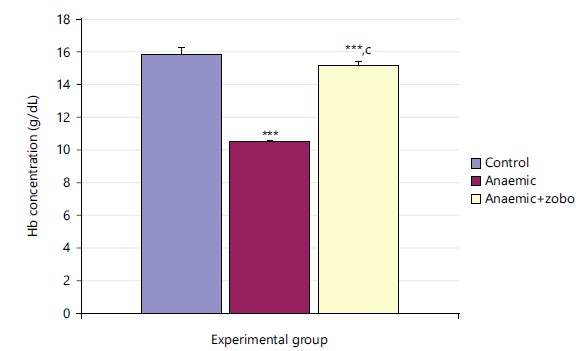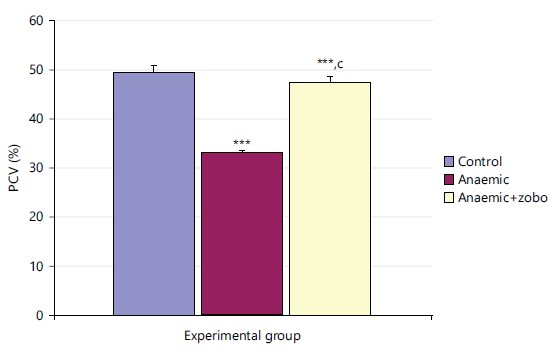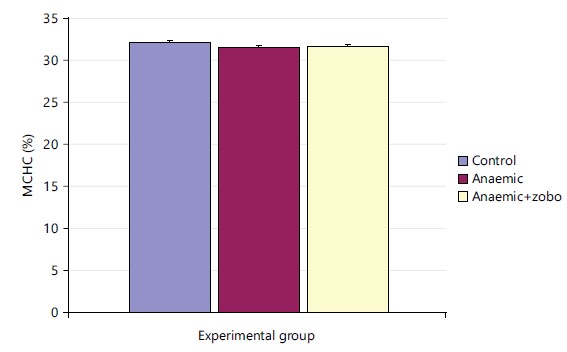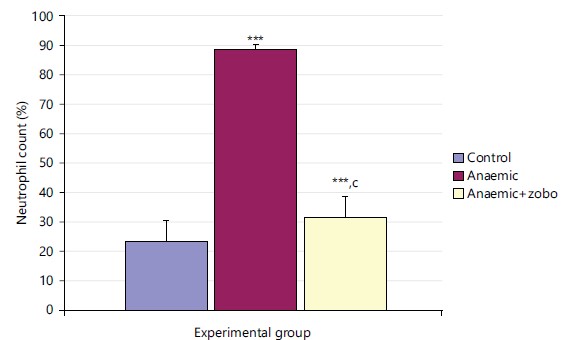Use of Hibiscus sabdariffa in Ameliorating Anaemia in Wister Rats Induced with Phenylhydrazine
| Received 26 Oct, 2023 |
Accepted 09 Apr, 2024 |
Published 31 Dec, 2024 |
Background and Objective: Hibiscus sabdariffa L. is a medicinal plant that is a member of the known worldwide for treating different diseases. This study is aimed at evaluating the effects of Hibiscus sabdariffa aqueous leaf extraction cellular elements of phenylhydrazine-induced anaemia in rats (i.e., haemolyticanaemia). Materials and Methods: Three groups comprised of control group (8), anaemic group (8) and the treated group (10). The aqueous extract of Hibiscus sabdariffa was administered in constant doses of 200 kg/b.wt., for 14 days. At the end of the feeding requirement through cardiac puncture blood samples for haematological analyses were collected into clean sample bottles containing Ethylenediaminetetraacetic acid (EDTA) at 1.5-2 mg of blood. Results: The results revealed that there was a significant increase (p<0.01) in Haemoglobin concentration (Hb) and Packed Cell Volume (PCV) caused by the aqueous extract in the haemolytic anaemic rats. However, the extract did not cause any noticeable effect on Mean Corpuscular Haemoglobin Concentration (MCHC) and total white blood cells (TWBC) compared with that of the normal control rats. Conclusion: It was found that consumption of the aqueous extract of Hibiscus sabdariffa leaves extract may alleviate anaemic conditions and improve oxygen-carrying capacity of red cells as well as boost the immune system.
INTRODUCTION
Hibiscus sabdariffa L. is a globally recognized medicinal plant. It belongs to the malvaceae family and is used in treating different cardiovascular diseases. It is also known as Roselle (English), l’oiselle (French), Spanish (Jamaica), Karkade (Arabic), Bissap (Wolof) and Sour Tea (Farsi), Zobo in Western Nigeria (the Yorubas in Nigeria call the white variety Isapa (Pronounced Ishapa), Zoborodo in Northern Nigeria1. Its flowers contain polyphenolic acids, flavonoids and anthocyanins with a reasonable antioxidant activity.
There are numerous studies regarding the component of Hibiscus sabdariffa and their multipurpose activities in the treatment of various diseases, especially those related to the cardiovascular system2. The calyces of Hibiscus sabdariffa are frequently incorporated in numerous contemporary commercial mixtures of cold and hot beverages, owing to their appealing taste and versatile applications in decorative, culinary and medicinal contexts. In Egypt and Sudan, this plant is employed as a cooling beverage to alleviate body temperature, address cardiac issues and serve as a diuretic3.
In African traditional medicine, it has been used for its spasmolytic, antibacterial, cholagogic, diuretic and anthelmintic properties. Additionally, across the African continent, it is employed for treating cough and sore throat, moreover, the leaf pulp is transformed into a topical remedy for external wounds and abscesses4. In Europe, the dried calyces (the cuplike structures that are formed by the sepals) are predominantly consumed as tea. This plant is often combined with lemon balm and St. John’s loot to address restlessness and difficulties in initiating sleep5.
Throughout history, Hibiscus sabdariffa has been employed in traditional medicine to treat high blood pressure, liver ailments and fever conditions. In substantial quantities, hibiscus tea serves as a gentle laxative, demonstrating tolerance and minimal impact on liver and kidney function at lower dosages. However, potential liver toxicity may arise when taken in excessive amounts6.
In loan, it is traditionally used in treatment for high blood pressure which is the focus of several studies, as is cholesterol reduction studies on total cholesterol, high-density lipoprotein and low-density lipoprotein cholesterol with Hibiscus sabdariffa tends to increase them with relative significance to their initial values7. Several studies have also reported negative effects while others had no significant effect on these parameters especially in animal models2. It is thought that the antioxidant and diuretic effects of hibiscus are its most important mechanism in lowering blood pressure.
Hibiscus tea is highly esteemed for its appetite-suppressing, hangover-relieving and circulation-enhancing properties. Its most significant advantage, however, lies in its contribution to cardiovascular health. In a 2008 study presented by the American Heart Association, researchers discovered that consuming three cups of hibiscus tea daily could reduce blood pressure by up to 13.2 percent in pre-hypertensive and mildly hypertensive adults. As a natural diuretic, hibiscus helps widen arteries and might function as a natural angiotensin-converting enzyme inhibitor, thereby slowing the release of hormones that constrict blood vessels8.
One report says that the plant is of value in the treatment of arteriosclerosis and is an intestinal antiseptic, though it does not say which part of the plant is used9. Anaemia is a medical condition in which the oxygen-carrying capacity of blood decreases. It mainly results due to the reduction of in number of red blood cells or reduction in the amount of hemoglobin present10. The extract of Hibiscus sabdariffa L. (MALVACEAE) is widely consumed with people attributing it to providing haematological benefits, however, to our knowledge, no scientific studies have been conducted to substantiate this claim11.
The purpose of this current study is to assess the impact of calyx extraction on certain haematological parameters (haemoglobin concentration, haematocrit (packed cell volume), mean cell haemoglobin concentration total and differential white cell) in albino rats. By doing so, the study aims to determine the potential therapeutic effectiveness of this extraction in addressing anaemia.
MATERIALS AND METHODS
Study area: This study was carried out in physiology laboratory, medical center, University of Calabar, Nigeria which lasted for 6 months i.e., from May to October, 2022.
Dried red calyces of Hibiscus sabdariffa were purchased from a local market in Calabar, Nigeria. The dried calyces of about 30 g were soaked in 2 L of water and left for 24 hours. Thereafter, the soaked substance was filtered using a funnel12. The extract was bottled and refrigerated. Different concentration of this extract was administered orally according to body weight.
Procurement and management of experimental animals: Twenty eight adult male albino rats weighing between 100-150 g were obtained from the Department of Human Physiology, University of Calabar, Calabar, Nigeria. The rats had no history of drug consumption (i.e., they have not been used for any investigation). They were kept in wooden cages perforated to allow ventilation with specially made containers for feed and water in a clean experimental animal house. The rats had unhindered access to feed and clean drinking water. All the animals were maintained under standard laboratory conditions for temperature, humidity and light throughout the experiments.
Experimental design: The rats were allowed for 18 days to acclimatize to their new environment. A completely randomized block design was used for the experiment with 28 adult male albino rats divided into three groups of eight control, eight anaemic and ten anaemic+zobo treated rats each.
The animals in the first group were used as the control groups. They were fed with top feeds and water ad libitum. The second group of animals was given 0.04 mL i.e., 40 mg in body weight of phenylhydrazine intraperitonally and rat feed daily. The third groups were given 0.04 mL of phenylhydrazine intraperitonially13 and different concentrations of aqueous extract of Hibiscus sabdariffa orally with rat feed daily.
All groups of animals were fed ad libitum for 14 days and they had access to drinking water. As 5 mL of blood samples were collected using different cardiac punctures through a modified procedure described by Ohwada14 into twenty-eight EDTA bottles representing the two test groups and the control group. The process of collecting this blood sample involved applying a light inhalation anesthesia of ether chloroform mixture in a bell jar, the animal is left here for 1-2 min to inhale the anesthesia. Blood was drawn from the right atrium after opening up the animal’s chest as it lay on the dissecting board on its back.
Preparation of phenylhydrazine: As 0.1 mL was measured from a stock solution of phenylhydrazine and diluted with 20 mL of dextrose saline in a measuring cylinder to form 0.02 mL.
Inducement/administration of anaemia: Anaemia was induced by phenylhydrazine. Phenylhydrazine was previously diluted in a DMSO solution to one-tenth in distilled water. It was administered to rats intraperitoneally (IP) at a dose of 40 mg/kg of body weight15,16.
Statistical analysis: The results were expressed on the Mean±Standard Deviation (SD) and statistical analysis was carried out using SPSS software, version 16.0 (SPSS Inc. Chicago II, USA). Differences among the groups were investigated using a One-way Analysis of Variance (ANOVA) followed by a student’s t-test. The p<0.001 was considered statistically significant. Variant means were separated using multiple range Duncan’s post hoc test.
Ethical consideration: Ethical approval for the use of laboratory animals was sorted for and obtained from ethical committee for the use of animals in Faculty of Medical Sciences, College of Medical Sciences, University of Calabar, Nigeria.
RESULTS
The experiment performed was to determine the effect of aqueous leaf extract of Hibiscus sabdariffa on some haematological parameters of phenylhydrazine-induce anaemia. The results obtained on the two groups (control and test) are shown in Fig. 1-7.

|

|
Comparison of haemoglobin concentration in control, anaemic and anaemic+zobo treated rats: The mean haemoglobin concentrations in the control, anaemic and anaemic+zobo-treated groups were 15.83±0.39, 10.47±0.12 and 15.13±0.22 g/dL, respectively. The results show that the haemoglobin concentration in the anaemic group was significantly lower (p<0.001) compared to control. However, the haemoglobin, concentration in the anaemic+zobo treated group was significantly higher (p<0.001) compared to control group and anaemic group respectively (Fig. 1).
Comparison of packed cell volume in control, anaemic and anaemic+zobo treated rats: The mean packed cell volume in control, anaemic and anaemic+zobo treated groups were 49.33±1.45, 00±0.58 and 47.50±1.00%, respectively. The results show that the packed cell volume in the anaemic group was significantly lower (p<0.001) compared to control. However, the mean packed cell volume in the anaemic+zobo treated group was significantly higher (p<0.001) compared to control group and anaemic group respectively. This is illustrated in Fig. 2.

|

|
Comparison of Mean Corpuscular Haemoglobin Concentrations (MCHC) in control, anaemic and anaemic+zobo treated rats: The mean MCHC concentrations in the control, anaemic and anaemic+zobo treated groups were 32.27±0.20, 31.67±0.27 and 31.83±0.25%, respectively. The results show that there was no significant difference in MCHC concentration among the groups. This is shown in Fig. 3.
Comparison of total white blood cell counts in control, anaemic and anaemic+zobo treated rats: Figure 4 shows that the mean total white blood cell counts in the control, anaemic and anaemic+zobo-treated rats were 10.00±3.22×109/L, 14.28±15.5×109/L and 14.58±3.37×109/L, respectively. The results showed that there was a significant difference in total white blood cell count among the groups.
Comparison of neutrophil counts in control, anaemic and anaemic+zobo treated rats: The mean neutrophil counts in control, anaemic and anaemic+zobo treated groups were 23.67±6.98, 89.67±1.76 and 31.75±7.34%, respectively. The results showed that the neutrophil count in the anaemic group was significantly higher (p<0.001) compared to the control group. However, the neutrophil count in the anaemic+zobo-treated group was significantly lower (p<0.001) compared to anaemic group (Fig. 5).

|

|
Comparison of eosinophil count in control, anaemic and anaemic+zobo treated groups: The mean eosinophil counts in the control, anaemic and anaemic+zobo-treated groups were 0.67±0.33, 0.33±0.33 and 1.25±0.29%, respectively. The results showed that there was no significant difference in eosinophil count among the groups (Fig. 6).
Comparison of lymphocyte count in control, anaemic and anaemic+zobo treated groups: The mean lymphocyte count in the control, anaemic and anaemic+zobo-treated groups were 72.67±3.84, 10.00±2.08 and 68.00±7.64%, respectively. The results showed that lymphocyte count in anaemic group was significantly lower (p<0.001) compared to the control group, but significantly higher (p<0.001) compared to anaemic group (Fig. 7).

|
DISCUSSION
Two weeks of administration of the aqueous extract of Hibiscus sabdariffa plant showed a marked improvement in the Haemoglobin (Hb) and Packed Cell Volume (PCV) values of anaemia rats when compared with control rats. These results agreed with the findings of Umar et al.17 and Ahmed et al.18. The difference is only on the part of the Hibiscus sabdariffa used, concentration administered and method of induction of Anaemia. While this work is on phenylhydrazine-induced anaemia and the leaves of Hibiscus sabdariffa, the others are on haemorrhagic anaemia and calyx and seeds of Hibiscus sabdariffa, respectively. It was also in collaboration with work done by Peter et al.11, which suggested that the extract calyx used in their work has favorable sequel19 on erythrocytes at low doses and unsustainable at high doses.
There was no significant difference in the Mean Corpuscular Haemoglobin Concentration (MCHC), MCHC among the groups which would have been an indication of change in size and colour intensity of the red cells. The effect of consumption of the Hibiscus sabdariffa therefore may not affect the size and intensity of the red blood cells.
The result also showed an increase in total white blood cells in the anaemic and extract-treated groups when compared with the control even though they were each not significantly different among the groups. In the differential count, the increase in neutrophils in the anaemic group is an indication of infection (Fig. 5). The consumption of zobo reduced the neutrophils showing that there is an improved state of health. The increase in the lymphocytes (Fig. 7) shows that ingestion of Hibiscus sabdariffa enhances the immune system to be able to fight infections. This was in agreement with the works of Peter et al.11 and Tazoho et al.20.
Researchers have demonstrated that the ethanolic extract of Hibiscus sabdariffa’s calyces exhibit substantial hyperlipidemic activity, followed by the ethanolic extract of its leaves. Upon examining the histopathological findings, they observed that rats fed with Hibiscus sabdariffa extracts experienced a decrease in cholesterol-induced granular degeneration. These results imply that the ethanolic extracts of the plant's calyces and leaves, which contain polyphenols and flavanols, possess significant antioxidants and antihyperlipidemic properties21. It is therefore recommended that the use of the aqueous extract of Hibiscus sabdariffa (zobo drink) be used in the management of anaemia and further studies should be carried out to provide more understanding of the association of aqueous extract of Hibiscus sabdariffa and haematological parameters.
CONCLUSION
The ingestion of an aqueous extract of Hibiscus sabdariffa may improve the haemoglobin and packed cell volume and therefore improve oxygen-carrying capacity of the blood. It does not invariably alter the size or shape of the red cell. The ingestion of aqueous extract of Hibiscus sabdariffa also helps improve the immune system, as seen in the elevated lymphocytes which help fight infection. The use of Hibiscus sabdariffa therefore to ameliorate the anaemic state may be considered.
SIGNIFICANCE STATEMENT
This study was carried out to assess the effects of Hibiscus sabdariffa aqueous leaf extracts on cellular elements of phenylhydrazine-induced anaemia in rats. The results revealed that Haemoglobin concentration (Hb) and Packed Cell Volume (PCV) were observed to be significantly increased compared to healthy controls while Mean Corpuscular Haemoglobin Concentration (MCHC) and total white blood cell (TWBC) when compared to those of normal control rats were not altered. Therefore, the ingestion of an aqueous extract of Hibiscus sabdariffa is recommended as it has been shown to be beneficial in improving haemoglobin concentration and packed cell volume in anaemia and also helps in boosting the immune system seen by the increase in the lymphocyte count.
REFERENCES
- Yu, C.H., Y.T. Lin, H.L. Su, K.W. Kan and F.C. Liu et al., 2019. Unripe fruit extracts of Mangifera indica L. protect against AGEs formation, melanogenesis and UVA-induced cell damage. Food Nutr. Sci., 10: 188-197.
- Onyenekwe, P.C., E.O. Ajani, D.A. Ameh and K.S. Gamaniel, 1999. Antihypertensive effect of roselle (Hibiscus sabdariffa) calyx infusion in spontaneously hypertensive rats and a comparison of its toxicity with that in Wistar rats. Cell. Biochem. Funct., 17: 199-206.
- Leung, A.Y. and S. Foster, 1996. Encyclopedia of Common Natural Ingredients: Used in Food, Drugs, and Cosmetics. 2nd Edn., John Willy and Sons, Hoboken, New Jersey, ISBN-13: 9780471508267, Pages: 649.
- Balunas, M.J. and A.D. Kinghorn, 2005. Drug discovery from medicinal plants. Life Sci., 78: 431-441.
- Marderosian, A.H.D., 1991. The need for cooperation between modern and traditional medicine. HerbalGram, 24: 30-37.
- Hopkins, A.L., M.G. Lamm, J.L. Funk and C. Ritenbaugh, 2013. Hibiscus sabdariffa L. in the treatment of hypertension and hyperlipidemia: A comprehensive review of animal and human studies. Fitoterapia, 85: 84-94.
- Chen, C.C., J.D. Hsu, S.F. Wang, H.C. Chiang and M.Y. Yang et al., 2003. Hibiscus sabdariffa extract inhibits the development of atherosclerosis in cholesterol-fed rabbits. J. Agric. Food Chem., 51: 5472-5477.
- Ali, B.H., N. Al Wabel and G. Blunden, 2005. Phytochemical, pharmacological and toxicological aspects of Hibiscus sabdariffa L.: A review. Phytother. Res., 19: 369-375.
- Kwame, A., 2021. Integrating traditional medicine and healing into the Ghanaian mainstream health system: Voices from within. Qual. Health Res., 31: 1847-1860.
- Kaboré, B., M. Koala, M. Nitiema, W.R.C. Ouedraogo and S. Compaoré et al., 2022. Phytochemical screening by high-performance thin-layer chromatography, antioxidant activities and acute toxicity of trunk barks extracts of Lannea velutina A. rich. Am. J. Anal. Chem., 13: 365-381.
- Peter, E.L., S.F. Rumisha, K.O. Mashoto, O.M.S. Minzi and S. Mfinanga, 2017. Efficacy of standardized extract of Hibiscus sabdariffa L. (Malvaceae) in improving iron status of adults in malaria endemic area: A randomized controlled trial. J. Ethnopharmacol., 209: 288-293.
- Lakenbrink, C., S. Lapczynski, B. Maiwald and U.H. Engelhardt, 2000. Flavonoids and other polyphenols in consumer brews of tea and other caffeinated beverages. J. Agric. Food Chem., 48: 2848-2852.
- Moreau, R., D.T. Malu, M. Dumais, E. Dalko and V. Gaudreault et al., 2012. Alterations in bone and erythropoiesis in hemolytic anemia: comparative study in bled, phenylhydrazine-treated and Plasmodium-infected mice. PloS One, 7.
- Ohwada, K., 1986. Improvement of cardiac puncture in mice. Exp. Anim., 35: 353-355.
- Diallo, A., M. Gbeassor, A. Vovor, K. Eklu-Gadegbeku and K. Aklikokou et al., 2008. Effect of Tectona grandis on phenylhydrazine-induced anaemia in rats. Fitoterapia, 79: 332-336.
- Wong, P.K., S. Yusof, H.M. Ghazali and Y.B. Che Man, 2002. Physico-chemical characteristics of roselle (Hibiscus sabdariffa L.). Nutr. Food Sci., 32: 68-73.
- Umar, I., N. Maryoms, E. Daikwo, A. Gidado, L. Buratai, I. Igbokwe and M. Ibrahim, 2009. The effect of aqueous extracts of Hibiscus sabdariffa (Sorrel) calyces on heamatological profile and organ pathological changes in Trypanasoma congolense-infected rat. Afr. J. Tradit. Complementary Altern. Med., 6: 585-591.
- Ahmed, R.H., A.W.H. Mohammed, H.M. El Hadi and M.Y. El Khalifa, 2013. The effect of aqueous extract of Hibiscus sabdariffa seeds on hematological parameters of anemic rats. Int. J. Phytomed., 5: 278-281.
- Mojiminiyi, F., B. Pereye, M. Ndakotsu, N. Ndodo, D. Ikhuenbor and V. Igbokwe, 2022. Effect of Hibiscus sabdariffa calyx extract on haematologic indices in sickle cell anaemia in-vitro. Afr. J. Biomed. Res., 25: 261-264.
- Tazoho, G.M., I. Gouado, M. Ndomou, S.T. Bonsi, Y.M. Wamba and E.E. Agbor, 2016. Clinical, hematological and biochemical health benefit effects of Hibiscus sabdariffa Lin dried calyces beverage in human. Food Nutr. Sci., 7: 383-395.
- Ochani, P.C. and P. D'Mello, 2009. Antioxidant and antihyperlipidemic activity of Hibiscus sabdariffa Linn. leaves and calyces extracts in rats. Indian J. Exp. Biol., 47: 276-282.
How to Cite this paper?
APA-7 Style
Okpokam,
D.C., Uzokwe,
J.I., Anyanwu,
S.O., Obembe,
A.O. (2024). Use of Hibiscus sabdariffa in Ameliorating Anaemia in Wister Rats Induced with Phenylhydrazine
. Asian Science Bulletin, 2(4), 316-324. https://doi.org/10.3923/asb.2024.316.324
ACS Style
Okpokam,
D.C.; Uzokwe,
J.I.; Anyanwu,
S.O.; Obembe,
A.O. Use of Hibiscus sabdariffa in Ameliorating Anaemia in Wister Rats Induced with Phenylhydrazine
. Asian Sci. Bul 2024, 2, 316-324. https://doi.org/10.3923/asb.2024.316.324
AMA Style
Okpokam
DC, Uzokwe
JI, Anyanwu
SO, Obembe
AO. Use of Hibiscus sabdariffa in Ameliorating Anaemia in Wister Rats Induced with Phenylhydrazine
. Asian Science Bulletin. 2024; 2(4): 316-324. https://doi.org/10.3923/asb.2024.316.324
Chicago/Turabian Style
Okpokam, Dorathy, Chioma, Jennifer Ifunanya Uzokwe, Stanley Obialo Anyanwu, and Agona Odey Obembe.
2024. "Use of Hibiscus sabdariffa in Ameliorating Anaemia in Wister Rats Induced with Phenylhydrazine
" Asian Science Bulletin 2, no. 4: 316-324. https://doi.org/10.3923/asb.2024.316.324

This work is licensed under a Creative Commons Attribution 4.0 International License.




